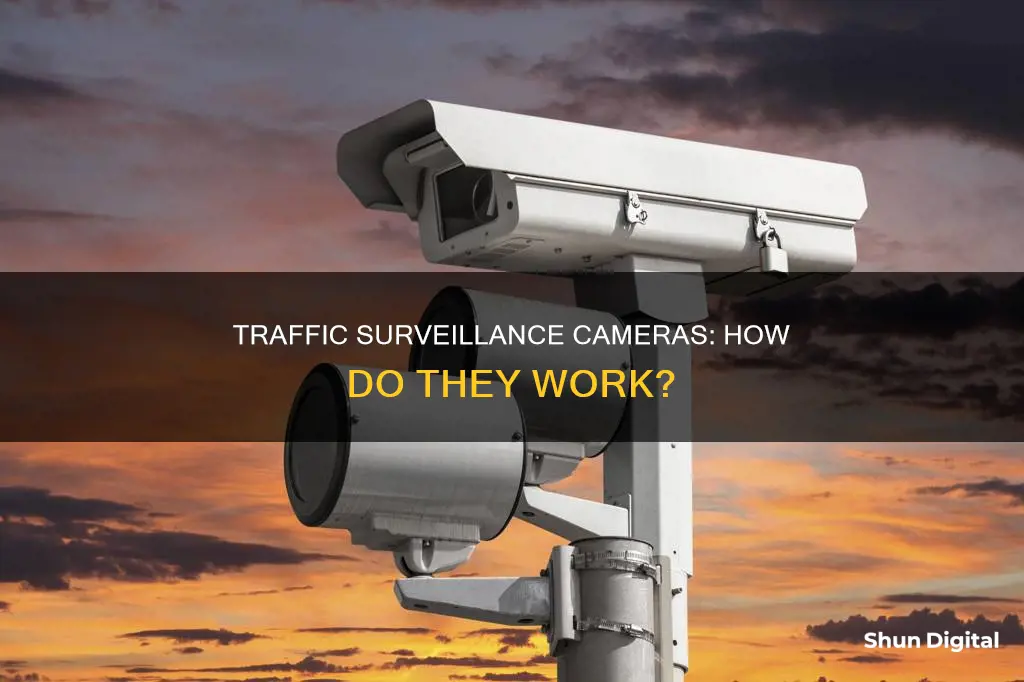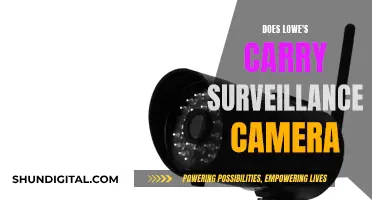
Traffic surveillance cameras are video cameras that observe vehicles on roads and are typically installed along major roads such as highways, freeways, expressways, and arterial roads. They are often connected by optical fibres and powered by solar panels or alternative power sources to provide consistent imagery without power outages. These cameras are distinct from road safety cameras, which are installed to enforce road rules by capturing still photos of violations. Traffic surveillance cameras are used for observation and can be remotely controlled to focus on incidents or areas outside their field of view. They are particularly useful in tunnels, where safety equipment can be activated remotely based on the information they provide. They are also used to monitor traffic flow, detect traffic violations, and improve road safety.
| Characteristics | Values |
|---|---|
| Purpose | Detecting motoring offences, including speeding, red-light running, toll booth avoidance, unauthorised use of bus lanes, and congestion charge avoidance |
| Installation Type | Fixed, portable, or mobile |
| Installation Location | Beside or over a road, mounted on a pole or gantry, installed in an enforcement vehicle, or mounted on a bus |
| Power Source | Mains power, solar panels, or other alternative power sources |
| Image/Video Type | Still photos or lower-resolution video |
| Image/Video Trigger | Vehicle presence, motion, or speed |
| Image/Video Resolution | High image resolution for road safety cameras, lower resolution for traffic cameras |
| Connectivity | Optical fibres, 4G LTE transmission technology |
| Data Storage | Local storage with strong encryption |
| Data Analysis | Advanced AI technology |
| Use Cases | Vehicle identification, automatic number plate recognition, speed measurement, traffic violation detection, tolling, maintaining smooth passenger flow, worker and equipment safety, and crime prevention and investigation |
What You'll Learn
- Traffic surveillance cameras are used to monitor traffic flow and detect incidents
- They can be used to prevent and investigate traffic violations
- They can be used to gather data on traffic patterns and road development
- They can be used to monitor and enforce speed limits
- They can be used to improve safety for workers and equipment at road construction sites

Traffic surveillance cameras are used to monitor traffic flow and detect incidents
Traffic surveillance cameras are an important component of intelligent transportation systems, serving a variety of purposes, including monitoring traffic flow and detecting incidents. These cameras are typically installed on major roads, such as highways, freeways, expressways, and arterial roads, and are strategically placed to capture a clear view of the surrounding area.
One of the primary functions of traffic surveillance cameras is to monitor traffic flow. They provide valuable real-time data on traffic patterns, congestion, and vehicle speeds, enabling transportation authorities to make informed decisions and improve traffic management. For example, by identifying areas of heavy congestion, transportation departments can implement measures to enhance traffic flow and reduce travel times for commuters. Additionally, these cameras can assist in detecting and managing incidents, such as accidents or roadworks, by providing live video footage to a monitoring center, which can then coordinate an appropriate response.
Traffic surveillance cameras are also essential for enforcing road rules and improving road safety. They can detect and capture evidence of traffic violations, such as speeding, running red lights, or unauthorized use of bus lanes. This helps hold drivers accountable for their actions and can lead to the issuance of tickets or fines. In some cases, these cameras can even assist in identifying vehicles involved in hit-and-run incidents or other traffic-related crimes.
Furthermore, traffic surveillance cameras play a crucial role in tolling, particularly in open road tolling systems. By capturing images of license plates, these cameras enable the billing of motorists through automatic number-plate recognition technology. This technology also aids in maintaining a smooth passenger flow, reducing congestion at toll booths, and enhancing the overall efficiency of the tolling process.
While some people may have privacy concerns about the use of traffic surveillance cameras, it is important to note that these cameras are typically installed in public areas, where there is no expectation of privacy. Additionally, the benefits of improved traffic management, enhanced road safety, and efficient tolling outweigh the potential privacy concerns.
In conclusion, traffic surveillance cameras are a valuable tool for monitoring traffic flow, detecting incidents, enforcing road rules, facilitating tolling, and improving overall road safety. By providing real-time data and capturing critical events, these cameras play a crucial role in modern transportation systems, helping to keep commuters safe and informed.
Charging the Kimuvin Spy Pen Camera: A Step-by-Step Guide
You may want to see also

They can be used to prevent and investigate traffic violations
Traffic surveillance cameras are video cameras used to observe vehicular traffic on roads. They are typically installed on highways, freeways, expressways, and arterial roads. These cameras can be used to prevent and investigate traffic violations in several ways.
Firstly, they can be placed at traffic signals, busy roads, or intersections to record traffic patterns and gather data on traffic flow. This information can be used to identify areas of congestion and implement measures to improve traffic management. For instance, the built-in analytics system in some cameras can detect traffic build-up and automatically notify road users via traffic warning signs.
Secondly, traffic surveillance cameras are crucial for enforcing traffic rules and regulations. They can detect and capture images of vehicles that violate traffic laws, such as speeding, running red lights, or making illegal turns. These cameras are often linked to an automated ticketing system, allowing for efficient enforcement of traffic rules.
Additionally, these cameras can assist in investigating traffic accidents and bottlenecks. By using video content analytics software, law enforcement agencies can quickly review traffic videos and identify relevant details, such as the direction of traffic, vehicle type, and speed. This helps pinpoint evidence and facilitate a faster and more accurate investigation process.
Furthermore, traffic surveillance cameras with license plate recognition (LPR) technology can aid in tracking down traffic violators. LPR enables the detection and identification of license plates, allowing law enforcement to locate and take appropriate action against offenders. This technology can also be used to calculate the average speed of vehicles and enforce speed limits effectively.
Lastly, the data gathered by these cameras can be aggregated to identify long-term traffic trends and patterns. By analysing this data, law enforcement agencies can determine hotspots for traffic violations and deploy resources more efficiently. Overall, traffic surveillance cameras play a vital role in preventing and investigating traffic violations, ultimately contributing to improved road safety.
Charging Your Polaroid Z2300: A Quick Guide
You may want to see also

They can be used to gather data on traffic patterns and road development
Traffic surveillance cameras are an effective tool for gathering data on traffic patterns and road development. They are typically placed at strategic locations, such as intersections, on-ramps, and roads with congestion, to provide a comprehensive view of traffic flow. The cameras are often mounted on poles, bridges, or other structures to capture images or videos of the surrounding area.
One of the key benefits of traffic surveillance cameras is their ability to enhance data gathering for better road planning and development. The cameras provide real-time monitoring of traffic conditions, allowing authorities to identify congestion hotspots and peak traffic times. This data is invaluable for future road development and construction work, as it helps inform decisions on improving traffic flow and reducing congestion.
For example, a state transportation department can use mobile surveillance cameras to monitor traffic flow on major roads and arteries. By collecting data on peak traffic times and accident hotspots, they can make informed decisions about road improvements and construction projects. Additionally, the rapid deployment of pole cameras allows for maximum coverage and a quick response to changing surveillance requirements.
Traffic surveillance cameras are also useful for measuring traffic patterns and determining traffic light timing. These cameras, often called traffic sensor cameras or traffic flow cameras, are mounted at intersections to monitor traffic flow and help manage traffic signal timing. While they don't track traffic violations, they play a crucial role in improving the efficiency and safety of the roads.
Another way traffic surveillance cameras aid in gathering data for road development is through the use of advanced technologies such as automatic number-plate recognition (ANPR) systems. These systems can detect the average speed of vehicles and provide valuable insights for road development projects. However, there are also concerns about privacy and the potential for mass surveillance of vehicle movements.
In summary, traffic surveillance cameras play a vital role in gathering data on traffic patterns and road development. They provide real-time monitoring, enhance data collection for planning purposes, and utilize advanced technologies like ANPR to improve road safety and efficiency. By leveraging the benefits of traffic surveillance cameras, authorities can make informed decisions to optimize traffic flow and road infrastructure.
Camera Tickets: Where Are They Mailed?
You may want to see also

They can be used to monitor and enforce speed limits
Traffic surveillance cameras are a type of video camera used to observe vehicular traffic on roads. They are typically placed at strategic locations such as complex intersections, roads with congestion, or areas with extreme weather conditions. These cameras are often mounted on poles, bridges, or other structures, providing a comprehensive view of traffic flow and conditions.
One of the key functions of traffic surveillance cameras is to monitor and enforce speed limits. They are equipped with sensors that can detect the speed of vehicles, enabling authorities to enforce speed limits and issue tickets to speeding drivers. These cameras utilise various technologies, including Doppler radar, LIDAR, stereo vision, and automatic number-plate recognition, to accurately measure vehicle speed.
The use of traffic surveillance cameras for speed limit enforcement has been proven effective in reducing accidents and injuries. Studies have shown a significant reduction in crashes, injury crashes, and fatal or severe injury crashes in areas with speed cameras. For example, the UK Department for Transport estimated a 22% reduction in personal injury collisions and a 42% decrease in fatalities or serious injuries at camera sites.
These cameras not only act as a deterrent but also help identify speeding vehicles and collect real-time traffic data. By comparing the time taken by a vehicle to travel between two distant points, these cameras can calculate the average speed and detect violations. Additionally, advanced traffic monitoring cameras, also known as traffic enforcement cameras, employ AI technology to detect irregular driving behaviours, such as exceeding speed limits, and predict accidents and congestion.
Traffic surveillance cameras play a crucial role in improving road safety and reducing speeding-related incidents. They provide valuable data for authorities to make informed decisions regarding traffic management strategies and road projects, ultimately contributing to safer roads for motorists and pedestrians alike.
Calibrating Camera Focus: The Paper Test
You may want to see also

They can be used to improve safety for workers and equipment at road construction sites
Traffic surveillance cameras are video cameras used to observe traffic on roads. They are typically installed along major roads such as highways and freeways, and are connected by optical fibres. They are often placed at intersections and alongside busy roads to record traffic patterns and gather data.
Traffic surveillance cameras can be used to improve safety for workers and equipment at road construction sites in several ways. Firstly, they can provide remote monitoring of the site, allowing officials to ensure the safety of workers and equipment. This is especially important at night or in low-visibility conditions when workers and equipment may be at a higher risk of accidents. The cameras can also help to deter theft of equipment and vandalism, as well as monitor for any unsafe behaviour by workers or passing motorists.
In addition, traffic surveillance cameras can assist with traffic management around construction sites. They can provide real-time data on traffic flow, allowing officials to make informed decisions about detours or temporary road closures. This can help to reduce congestion and improve safety for both workers and motorists.
Furthermore, traffic surveillance cameras can be used to detect and enforce traffic violations near construction sites. For example, they can identify vehicles that are speeding, failing to yield, or making illegal turns. This can help to improve safety for workers and reduce the risk of accidents. The cameras can also be used to monitor for traffic violations that may specifically endanger workers, such as driving under the influence or using a mobile phone while driving.
Overall, traffic surveillance cameras are a valuable tool for improving safety at road construction sites. They can help to protect workers and equipment, improve traffic management, and enforce traffic laws, ultimately contributing to a safer environment for all road users.
Button Cameras: How Do They Focus?
You may want to see also
Frequently asked questions
Traffic surveillance cameras are cameras that are put in specific places to enforce road rules and detect traffic violations. They are usually installed at intersections, along highways, freeways, and arterial roads.
Traffic surveillance cameras offer several benefits, including improved traffic flow, enhanced data gathering on traffic patterns and accident hotspots, crime prevention, and protection of workers and equipment at road construction sites.
Traffic surveillance cameras use technologies such as radar, laser, and optical character recognition to detect violations such as speeding, running red lights, and not wearing seatbelts. They can also be used for automatic number-plate recognition.
Yes, traffic surveillance cameras have been ruled legal and constitutional by multiple U.S. Circuit Courts of Appeals. However, there is opposition from some Americans who want them banned due to privacy concerns and other issues.
Traffic surveillance cameras are typically found at intersections and along major roads. They may be mounted on poles, gantries, or traffic light poles, and are often placed in areas with high congestion or accident rates.







